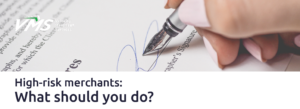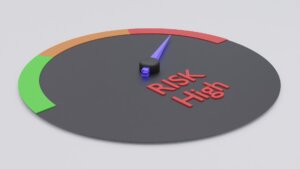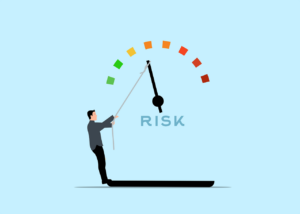
by Grace Barone

Are you continually getting rejected by payment processors? Or, if you finally get accepted you end up paying outrageous processing fees? If so, your business may be considered "high-risk". Whether you think its fair or not, high-risk businesses need to jump through a few more hoops to be able to start accepting payment. While it may take some more effort, businesses can seek out a high-risk merchant account. These accounts allow high-risk merchants to accept payments just like low-risk merchants. In this article, we'll explore the world of high-risk merchant accounts, how they work, and why they may be the perfect solution for your business.
What is a High-Risk Business?
There are a few different factors that payment processors take into consideration when assessing a businesses risk factor. A company that conducts business in an industry where the likelihood of chargebacks, fraud, and financial losses is higher than average is considered high-risk. Here are some of the things payment processors take into consideration when assessing a business;
Chargeback Rates:
A high chargeback rate may point to an issue with the company's goods or services, which may lead to dissatisfied customers disputing transactions with their banks.
Regulatory Compliance:
Some industries, like travel agents, cannabis, and adult products, are subject to more stringent regulatory compliance standards, which raises the possibility of financial losses and legal problems.
Reputation:
Due to the possibility of customer backlash and unwanted media attention, businesses that operate in industries with a bad reputation, such as adult entertainment or internet gambling, may be viewed as high-risk.
Business Model:
Due to the higher likelihood of chargebacks and financial losses, companies that rely on recurring billing or have a high average transaction value (ATV) may be regarded as high-risk.
Geographical Location:
Companies that are located in high-risk nations or that have a sizable clientele in nations with a high rate of credit card fraud may also be deemed high-risk.

In the payments industry, there is no centralized framework that decides which factors are risky. Instead, each bank, payment service provider, and payment processor creates its own criteria. While some businesses explicitly indicate that they don't work with certain industries, others accept applications from all candidates. In general, payment service providers are more picky about the kinds of businesses they accept than merchant account providers. You will be required to submit an application with information about your business in either situation.
Accounting and tax preparation.
Adult products or services.
Age-restricted items.
Automotive parts and accessories.
Bail bonds.
Cigarettes and tobacco.
Collections.
Computer software.
Credit repair.
Dating services.
Debt consolidation.
Diet and weight loss programs.
Digital downloads.
Document preparation.
Dropshipping.
Electronics.
Extended warranties.
Fantasy sports.
Financial services.
Firearms and firearms accessories.
Free trials.
Furniture.
Highly regulated industries, including cannabis.
Hunting and outdoor equipment.
Jet charter.
Legal services.
Mail-order transactions.
Multilevel marketing.
Nonprofit.
Nutraceuticals and supplements.
Online gaming and casinos.
Pawn shops.
Precious metals and coins.
Property.
Search engine optimization, or SEO, and search engine marketing, or SEM, services.
Self storage.
Smoking accessories.
Software as a service, or SaaS, companies.
Tasers and stun guns.
Tech support.
Travel and vacations.
Vape and e-cigarettes.
Web design.
Accepting subscription-style payments.
Being on the Member Alert to Control High-Risk Merchants, or MATCH list — a list managed by Mastercard that monitors merchant behavior, like chargeback history.
High average transaction sizes.
High sales volumes.
Highly regulated industries.
International sales.
Large number of card-not-present transactions.
Little to no business experience.
Long fulfillment time frames.
New or poor credit scores.
Past fraud or illegal activity.
Why some Businesses are Considered High-Risk
Based on that drop down, the list of possible high risk businesses is quite long. If you're a business owner and see your business type on the list, you may be confused as to why. If you're an ecommerce based business, all of your transactions are card-not-present transactions. These transactions have a greater risk of chargebacks and fraud. Since payment processors sometimes get stuck footing the bill on chargebacks, these kinds of businesses are considered high risk.
Businesses that have future deliverables are also considered high-risk. A product that will be made available in the future at a certain time is known as a future deliverable. It is something that is anticipated to be created, developed, or finished as part of a project or endeavor, whether it be something tangible or intangible. Furniture stores sometimes operate like this. You go in, see a piece of furniture you like, then the store orders that piece for you. Well, say it takes 30 days for orders to go in and the store goes out of business before an order is placed or arrives. The store now has 30 days of orders to refund or fulfill. The payment processor is now on the hook for reimbursing the customers that did not receive their order.
Website building and SEO services operate like this also. You pay someone to work on your website or SEO strategy. It takes time to complete that task. If the company you payed to do that for you goes out of business before the task is complete, you need to somehow get your money back. Again, the payment processor now needs to figure out how to return the funds. This is why it's considered high-risk.
What to Look for in a High-Risk Processor
If you've been deemed high-risk by payment processors, the next step is to find a processor that does high-risk accounts. Just because you're business is high-risk doesn't mean that you'll default on payments or partake in fraudulent behavior. While it may be harder to start accepting payment, it's not impossible. Make sure you're doing research on different processing options. Here are a few things to look for when searching for a high-risk merchant account.
On-shore or Off-shore?
- When looking for a payment processor that deals with high-risk merchant accounts, you want to make sure the company is "on-shore". What this means is that the payment processor is located in the same country as your business. This is important because there are a lot of variables at play if your processor is over seas. While off-shore payment processors may offer lower fees due to operating in a country with lower labor and operating costs. However, off-shore payment processors may also come with additional risks such as regulatory compliance issues or limited legal recourse in case of disputes.
Deposit Time
- While you search for a high-risk merchant account, deposit time is a crucial factor to take into account. It might affect your cash flow and the overall financial health of your company. The amount of time it takes for funds to be transferred into your account might range from one to several business days. To reduce the financial risks, payment processors may have longer settlement periods or hold a bigger proportion of cash in reserve. Delays in deposit times may be an issue for companies whose cash flow depends on timely access to funds.
Processing Limits
- When searching for a high-risk merchant account, processing limits are a crucial factor to take into account. Processing limitations describe the highest sales volume that a payment processor will let a merchant process in a certain period of time, typically monthly or annually. Payment processors may impose lower processing limitations in high-risk industries as a strategy to control their financial risks. This can be a concern for high-risk merchants who have a lot of sales, or work in fields where high-ticket items are sold. This can restrict their ability to handle transactions and expand their company. Look for a high-risk merchant account provider that can meet your company's sales volume and growth projections when looking at processing limits.
Addendums
- After a merchant account agreement has been established, more conditions or clauses may be added to it. These are referred to as addendums. The conditions of the original agreement may be amended or clarified in these addendums to better serve the interests of the merchant or payment processor. Addendums are particularly important in the context of high-risk merchant accounts. They can assist in addressing the special risks and difficulties connected to high-risk sectors. For instance, to reduce the risk of fraud, an amendment can specify precise chargeback limits or demand more supporting paperwork. Other examples of an addendum is stating that merchants can't key-in any transactions. It's important for high-risk merchants to carefully review any addendums before signing them. They should ensure that they fully understand the implications and potential risks.
Reserve Accounts
- Payment processors may require a higher percentage of sales be held in reserve accounts in high-risk businesses. This serves as extra security to reduce the financial risks. Due to the fact that a merchant cannot instantly access the money stored in reserve accounts, this can affect the merchant's cash flow. When considering a high-risk merchant account, it's important to carefully review the reserve account requirements to ensure that they are reasonable and manageable for your business. It would be ideal to find a payment processor that does not require this. Although typically there is some kind of reserve account connected to high-risk merchant accounts.

